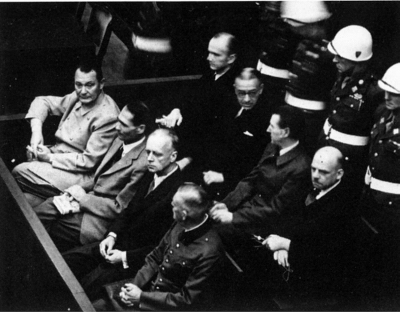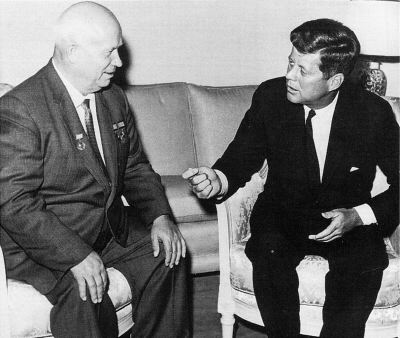History
Timeline of Key Points During the Cold War
The cold war could be considered in terms of freezes, times during which relations between the USA and USSR relations were bad, and thaws, times when relations improved.
FREEZE 1945 - 1962
1940s
1945: Yalta Conference -- Stalin, Churchill, Roosevelt met to discuss
- How defeat Hitler, Zones of occupation in Germany, Austria, Berlin and
Vienna.
1945: Potsdam -- Truman, Stalin, Atlee met to discuss - German, Austrian
boarders, Treatment of Nazis, Freedom in Germany, Reparations, all Germans
live in Germany. There were tensions over Poland, free-elections in Eastern/Soviet-Europe,
a clash of characters, and Soviet fears due to the A-bomb.

World Leaders Gathered in Nuremberg for the Nazi War Crimes Trial
1947: Truman Doctrine announced which outlines the US policy Communist
Containment- Truman declares an active role in the Greek Civil War. This
is because Britain is unable to continue supporting the Greek King’s
fight against the communists, there's an energy crisis in Britain in the
winter 1946-1947.
1947: Marshall Plan is announced (this is considered two halves of the
same walnut with Doctrine). It is believed economic hardship lead to communist
support, it was not necessarily an attack against USSR. The US did offer
to help the USSR as well, however the Russians were suspicious and refused.
1947-1952 Massive European spreading. This aided European recovery, stopped
the spread of communism, forced the creation of Cominform (Eastern European
countries gained all orders from the USSR) and Comecom (Eastern European
countries could only trade with other communist countries) Tension between
the US and USSR was heightened.
1948: Yugoslavia became an independent communist country after they rejected
USSR control.
1945-48: During this period there was significant Eastern-Europe expansion.
Why? -The USA believed they sought World domination, however the USSR
saw expansion as a way of providing defence against Germany by creating
a series of friendly states around their boarders.
1948: Trizonia estanblished -- U.S. British and French zones in Germany
united under one currency, the Deutschmark. This too was introduced in
western Berlin. Stalin was furious.
1948: Berlin Blockade begins, which resulted in the Berlin airlift crisis.
This was as a direct result of the Deutschmark being introduced in Germany.
The USSR saw Germany as a threat. The Berlin Blockade ended soon after
and Western Germany united. This was seen as a Containment victory. Effect
- Strong divide between communist and capitalist nations, NATO ratified
as a result of the Berlin Blockade.
1949: China -- Mao Zedong, a Communist, takes control of China. He was
friendly with Stalin and had poor relations with USA.
1949: Arms Race -- Soviets explode first atomic bomb (American H-bomb
developed shortly after in 1950)
1950s
1950: McCarthyism -- He begins Communist 'witch hunt' in the USA, people
were forced out of their jobs if they were believed to be Communists.
1950: Korean War -- First conflict of Cold War between US and communist
forces. It resulted in the creation of North and South Korea and was viewed
as a Containment victory.
1950 -- NSC 68 annouced (resulted in massive increase in U.S. military
spending). There was significant fear of communism (Korean war and McCarthyism
hightened this fear). China and USSR were now both communist and considered
a significant threat.
1953: Stalin dies -- formally taken over by Khrushchev in 1958

President Kennedy meets Khrushchev
1955: West-Germany joined NATO.
1955: Warsaw Pact formed as a result of west-Germany joining NATO.
1956: Khrushchev made a speech criticising Stalin -- He claimed he had
taken too much power, suggested greater freedom should be allowed within
the USSR - Resulted in hope for people in Eastern Europe -- lead to the
Hungarian Uprising. However, Mao saw this as an attack on his own leadership.
1956: Hungarian Uprising -- up until Stalin’s death Hungary was
ruled by Matyas Rakosi. He was a tyrant similar to Stalin but when Stalin
died he was replaced by Imre Nagy. He was seen as a moderate PM from 1953-55.
Serious rioting took place in Oct 1956, Nagy was appointed PM again. Faced
with a break down of communist rule Soviet troops entered, Nagy was imprisoned
and executed in 1958. USA refused to help the rebels unwilling to upset
the split.
1956: Communist Split -- Khrushchev visited China after visiting America.
The meeting went badly.
Reference Tools
Dictionary
Thesaurus
Maps
Scientific Calculator
Periodic Table
Translator
Unit Conversion
Divided Union
Introduction
Post War
The ‘Red Scare’
Civil Rights Movement
Non-Violent Direct Action
John F Kennedy
Lyndon Johnson
Growth of Black Power
The Woman’s Movement
The Student Movement
Nixon and Watergate
Cold War
Period 1945 - 1962
Period 1956 - 1962
Period 1962-1969
Period 1969 -1979
Period 1979 - 1985
Period 1985- 1991
